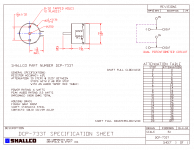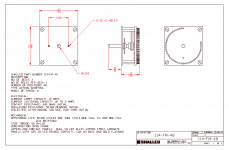Really is a hard job to determine transparency from a switch, but I believe it can be tested in that way comparing different qualities and mechanical solutions. Then, we also can establish if with the same construction, same kind of resistors, one arranged in ladder the other in series, one can have more fidelity to the audio signal. Other story is if this difference is small. I don't have a laboratory to do test and I don't want to invest much money to compare by myself several attenuators. But for analysis purpose we can guess what we want around the key points or at least ask for people that have experience on this regarding and that is what I am doing here. To achieve this goal, we can talk about transparency as an absolute (100% fidelity), so then we can say, less transparent, more transparent, etc.Once you get to audibly transparent (and both the series and ladder are), what's it matter which is "more audibly transparent"?
Clicks are generated any time switching is done when the signal is not instantaneously at zero (most of the time). The click is usually inaudible for most audio signals, but if you use a sine wave in the 20Hz to 60Hz range, you should be able to hear clicks as the switch goes between ranges.You will get switching clicks whatever type of switch you use and whatever type of resistor arrangement you use if there is DC present. However, make before break will give quieter clicks than break before make.
I haven't done much with stepped attenuators, and I doubt I could tell the difference if I had. But engineering-wise I like the series string, since the signal only goes through one switch contact.so, in your experience with those devices, do you have a preference on the resistors arrangement used, series or ladder? or depends on the components?
so, at the end, that is the critical part for degradation on the signal path, how much contacts have to deal to, not the amount of resistors?I haven't done much with stepped attenuators, and I doubt I could tell the difference if I had. But engineering-wise I like the series string, since the signal only goes through one switch contact.
I'm checking with Shallco and I would have to pass away because they don't fit the chassis of my integrated amp. They both are really huge, the open switch with 48 steps (2 15/16 height) or the closed with a brass can 30 steps (2 11/32 height) and I only have 51mm interior on my amp chassis. The only way will be canceling the volume control on my amp (it is placed between the first (input tube) and second stage (drivers tubes)) creating a sort of passive preamp in a separated chassis.A slight preference for the Shallco
food for thought
Attachments
Resistors are rarely a problem. Amount of resistors is not a problem - as I said, it may even be a very very slight advantage. Contacts are always a problem.beto1 said:so, at the end, that is the critical part for degradation on the signal path, how much contacts have to deal to, not the amount of resistors?
Therefore minimise the number of contacts, and use however many resistors are needed for the circuit. Of all the electronic components used in audio, resistors are by far the nearest to ideal behaviour (apart, perhaps, from wires).
finally
I think I will get the Acoustic Dimension series attenuator with SMD resistors([FONT=Arial, Helvetica, sans-serif]non-inductive, low noise, SMD metal film resistors)[/FONT]. It is about 40% cheaper than the ladder and it seems that is from public dominion that the possible improvement would be very small, adding disadvantages. Of course, I guess there is place for the ladder attenuator when one wants that tiny improvement assuming the risks. Well, I guess also that the ladder version is a more easy to tweak....well, I have never soldered a SMD resistor...maybe it is not that hard.
regards
Thanks DF96.Resistors are rarely a problem. Amount of resistors is not a problem - as I said, it may even be a very very slight advantage. Contacts are always a problem.
Therefore minimise the number of contacts, and use however many resistors are needed for the circuit. Of all the electronic components used in audio, resistors are by far the nearest to ideal behaviour (apart, perhaps, from wires).
I think I will get the Acoustic Dimension series attenuator with SMD resistors([FONT=Arial, Helvetica, sans-serif]non-inductive, low noise, SMD metal film resistors)[/FONT]. It is about 40% cheaper than the ladder and it seems that is from public dominion that the possible improvement would be very small, adding disadvantages. Of course, I guess there is place for the ladder attenuator when one wants that tiny improvement assuming the risks. Well, I guess also that the ladder version is a more easy to tweak....well, I have never soldered a SMD resistor...maybe it is not that hard.
regards
- Status
- Not open for further replies.

